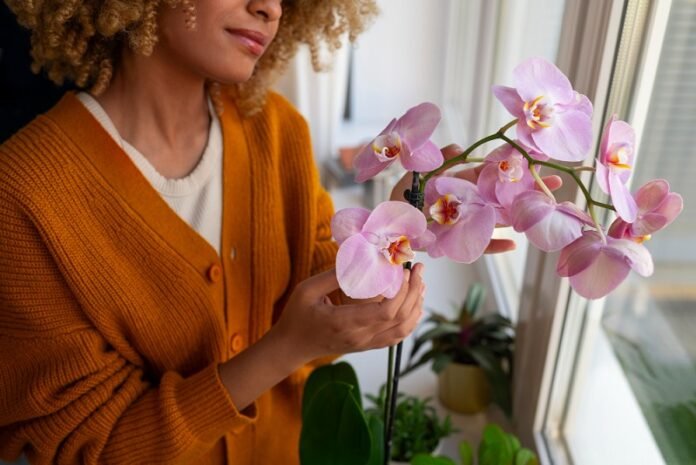African violets (Saintpaulia) are beloved houseplants known for their charming blooms and lush foliage. They are relatively easy to care for, but they do require some specific conditions to thrive. This article will delve into various aspects of African violet care, including common problems, indoor care tips, and frequently asked questions.
African Violets Care
Proper care is essential to keep African violets healthy and blooming. Here are some fundamental care tips:
1. Light Requirements:
African Violets thrive in bright, indirect light. For those learning how to grow African Violets, placing them near an east-facing window is ideal. Avoid direct sunlight, which can scorch the leaves.
2. Watering:
Proper watering is crucial for growing African Violets. Use room-temperature water and avoid getting water on the leaves to prevent spots. Bottom watering is recommended to keep the foliage dry.
3. Humidity and Temperature:
Maintain a humidity level of 40-60% and a temperature between 65°F and 75°F. These conditions mimic their native environment and are perfect for how to grow African Violets from a leaf or mature plant.
4. Soil:
Use a well-draining potting mix specifically formulated for African violets. These mixes are typically light and airy, providing the roots with the oxygen they need.
5. Fertilizing:
Feed African violets with a balanced, water-soluble fertilizer designed for blooming houseplants. Follow the package instructions and reduce feeding in the winter when growth slows.
6. Propagation:
If you’re interested in how to grow African Violets from a leaf, this can be a rewarding method. Take a healthy leaf cutting, place it in water or a potting mix, and new plants will form in a few weeks.
7. Outdoor Growth:
Many wonder, can African Violets grow outside? Generally, they are best kept indoors where their environment can be controlled. Outdoor conditions often don’t meet their specific needs for light, temperature, and humidity.
African Violets Care and Problems
Even with the best care, African violets can encounter problems. Here are some common issues and their solutions:
1. Yellow Leaves:
This can be caused by overwatering, poor lighting, or nutrient deficiencies. Check your watering routine and ensure the plant is getting enough indirect light. Consider repotting with fresh soil and feeding with a balanced fertilizer.
2. Leaf Spots:
Spots can appear from water droplets on the leaves. Always water from the bottom and avoid splashing water on the foliage.
3. Powdery Mildew:
This fungal disease appears as a white, powdery coating on leaves. Improve air circulation around the plant and avoid overhead watering. Fungicides can help control severe infestations.
4. Root Rot:
Caused by overwatering and poor drainage. Ensure your potting mix is well-draining and never let the plant sit in water.
Care for African Violets Indoors
African violets are popular indoor plants, and they can thrive with the right care:
1. Temperature:
Maintain indoor temperatures between 65-75°F (18-24°C). Avoid placing them near drafts, air conditioners, or heating vents.
2. Repotting:
Repot African violets every 6-12 months to refresh the soil and provide room for growth. Choose a pot that is only slightly larger than the current one to prevent root rot.
3. Pruning:
Remove dead or yellowing leaves and spent flowers to encourage new growth. This also helps prevent disease.
4. Pest Control:
Common pests include aphids, mites, and thrips. Use insecticidal soap or neem oil to treat infestations. Regularly inspect your plants to catch problems early.
How to Take Care of African Violets
To summarize, here are the key steps to taking care of African violets:
- Provide bright, indirect light.
- Water from the bottom and keep the soil moist.
- Maintain high humidity and moderate temperatures.
- Use a well-draining potting mix.
- Fertilize regularly with a balanced fertilizer.
- Monitor for common problems and address them promptly.
FAQ
Water your African violet when the top inch of soil feels dry. Bottom watering is preferred to keep leaves dry.
Yellow leaves can result from overwatering, poor lighting, or nutrient deficiencies. Adjust your care routine accordingly.
Yes, African violets can thrive under fluorescent grow lights. Place the lights 12-15 inches above the plants and provide 12-14 hours of light daily.
Use a humidity tray, group plants together, or use a room humidifier to increase humidity levels.
African violets can be propagated from leaf cuttings. Cut a healthy leaf with a short stem, insert it into moist potting mix, and cover it with a plastic bag to maintain humidity until roots develop.
Conclusion:
Mastering the art of African violet care requires a blend of knowledge, attention, and patience. By understanding the essential aspects of African violets care, addressing common problems, and applying specific indoor care techniques, you can ensure your plants thrive and flourish. Consistent monitoring and proper maintenance are key to preventing issues and promoting healthy growth. With the insights provided in this comprehensive guide, you’ll be well-equipped to cultivate beautiful and vibrant African violets, adding a touch of elegance and color to your home.










